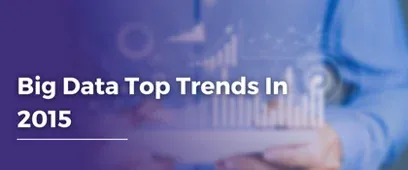Big Data Top Trends In 2015 | Big Data

Big Data is moving ahead with great strides in 2015 and is being used and represented across companies globally. The adoption rate of this revolutionary innovation has grown tremendously to increase its importance as a business function that’s reliable, secure and worthy of providing great value to customers. Here, we take stock of some major Big Data trends that are impacting the world of data in 2015. Read on for more.
Simple Interfaces for Non-Data Scientists
As more and more organizations are joining the massive data drive, finding the right talent for collecting, analyzing and making decisions based on Big Data is becoming more difficult with each passing day. In other words, companies are becoming reliant on outsourced consultants or too few in-house staff for meeting their data-centric requirements. With this in view, 2015 is expected to see the rise of more automated platforms with easy-to-use interfaces. These platforms will allow employees who have little or no specific data skill sets to handle complex back (simpler tasks too) to generate lucrative business results.
Easy Availability of Sensor Driven Data
In 2015, the Internet of Things may hit its tipping point. Yes, with the way in which IoT is evolving, it’s no small wonder that this technology will soon make its presence felt in all diverse industry verticals, and how. Here, the trend relates to sensor-to-sensor data that’s being accumulated, collated and analyzed via purely sensor based collection tools in multiple ways. From the kinds of settings that users are implementing on particular devices to the new ways in which objects are being made to interact with each other, sensor-based data is likely to witness a marked increase in popularity (also consider checking out this perfect parcel of information for data science degree).
However, it is quite unlikely to take over the current significance of transactional data that’s making up a large majority of data collection. So, gear up to see heightened levels of device-to-device data creations and collections in 2015. Yes, at the rate at which it is advancing, sensor-based data may well grow beyond transactional data in the next 5 years!
Valuable Customer Insights in the Offing
Even though sensor data is still basking in the glory reflected by transactional data, 2015 happens to be the year when the former is all set to offer multi-dimensional ways of generating deeper customer insights. Right from a deeper assessment of purchasing trends to geographical data and various oblique factors, this new technology is being used for tracking metrics over more areas. With Big Data wearables developing more trackable actions, a deeper understanding of consumer preferences and buying habits is inevitable.
Cloud Impacts Big Data Profits Positively
Today, the cloud seems to be everywhere and is continuing to be adopted in extreme volumes. A big percentage of this cloud growth is being driven by Big Data in 2015. This is evident by the fact that the revenues for the top 50 public cloud providers (public) has seen a whopping rise in the first two quarters itself. Big names such as Google Big Query, Amazon Redshift and Teradata have joined the Big Data bandwagon and are all set to notch high profitability figures by the end of this financial year.
NoSQL or SQL?
Though many Big Data watchers are still deliberating, NoSQL is taking big strides for grabbing the limelight. As per data analysts, 2015 has seen an unprecedented growth of NoSQL because of its high scalability and flexibility quotients. In addition, it has the ability to leverage the benefits of large-sized datasets faster. On the other hand, big names like Casandra, Couchbase, MarkLogic, and MongoDB are launching newer innovations in the SQL database market and are making heads turn with large-sized production implementations (also consider checking out this career guide for data science jobs).
Faster In-Memory Databases
With Big Data deluges increasing in the past few months, there has been a marked escalation in the rate at which results are required by organizations. Now, users are looking for more information and ways of making decisions in real-time. Reports based on historical data were passed in 2015. This trend has led to the introduction of fast-paced in-memory databases that are allowing companies different ways of accessing and analyzing data and taking quick actions when compared to regular databases.
Recognition of the Positives of HR Analytics
From easy tracking of employee happiness to the optimization of workflows, HR Analytics based on Big Data applications is being adopted radically in 2015. Organizations are waking up to the benefits of effective HR strategies and are fast gaining good ground on rival companies.
Overall, these Big Data trends in 2015 are impacting the commercial scenario in big ways. Early adopters and late entrants alike are using valuable streams of structured and unstructured data. This is mainly with regards to inventory status, customer purchasing habits, the transformation of business processes, and growth of their digital business. Are you still asking for more?